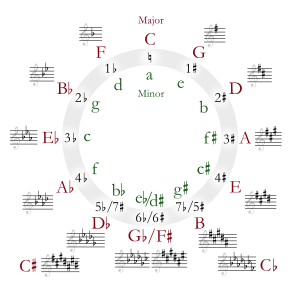Key (music)
Methods that establish the key for a particular piece can be complicated to explain and vary over music history.For example, modern trumpets are usually in the key of B♭, since the notes produced without using the valves correspond to the harmonic series whose fundamental pitch is B♭.(Such instruments are called transposing when their written notes differ from concert pitch.)In the Baroque it was common to repeat an entire phrase of music, called a ritornello, in each key once it was established.In rock and popular music some pieces change back and forth, or modulate, between two keys."This phenomenon occurs when a feature that allows multiple interpretations of key (usually a diatonic set as pitch source) is accompanied by other, more precise evidence in support of each possible interpretation (such as the use of one note as the root of the initiating harmony and persistent use of another note as pitch of melodic resolution and root of the final harmony of each phrase).Likewise, the horn, normally in the key of F, sounds notes a perfect fifth lower than written.For example, a brass instrument built in B♭ plays a fundamental note of B♭, and can play notes in the harmonic series starting on B♭ without using valves, fingerholes, or slides to alter the length of the vibrating column of air.Such "key coloration" was an essential part of much eighteenth- and nineteenth-century music and was described in treatises of the period.

Key (instrument)YouTube PremiumMajor Key (album)music theorymusical compositionclassical musicart musicpop musicchordsresolvedmajor or minorPopular songscommon practice periodcontrasting keysmodulationprogressionscadenceskey signaturerelativemodulateaccidentalsMixolydianDorianharmonytonal centertrumpetsharmonic seriestransposingconcert pitchcommon tonecircle of fifthsclosely related keyii-V7-I progressionfunctional harmonyDorian modePhrygiankey naming systemschord progressionsdiatonic contextphraseritornellosonata formtonicizationRomantic-eraarrangementschoruspopular musicFleetwood MacDreamsThe Rolling StonesUnder My Thumbmusical instrumentstransposing instrumentsclarinetsheet musicwhole toneperfect fifthbrass instrumentfundamentaltromboneharmonicaMozartclarinet concertotimbreequal temperamentintervalsmusical temperamentsfifthsdiatonicthirdsintonationwolf fifthPythagorean tuningPythagorean commaWilli ApelKent Wheeler KennanHugo RiemannRahn, JohnSteblin, RitascalesSharpsClosely relatedDiatonic scaleHomotonalMajor and minorMusic in all keysParallelSignatureNames and translationsTheoreticalTonalityInstrumentCadenceConsonance and dissonanceDiatonic functionSecondary functionFigured bassJust intonationNeotonalityOstinatoOtonality and utonalityParallel keyPolytonalityProgressive tonalitySchenkerian analysisTonality diamondVoice leading